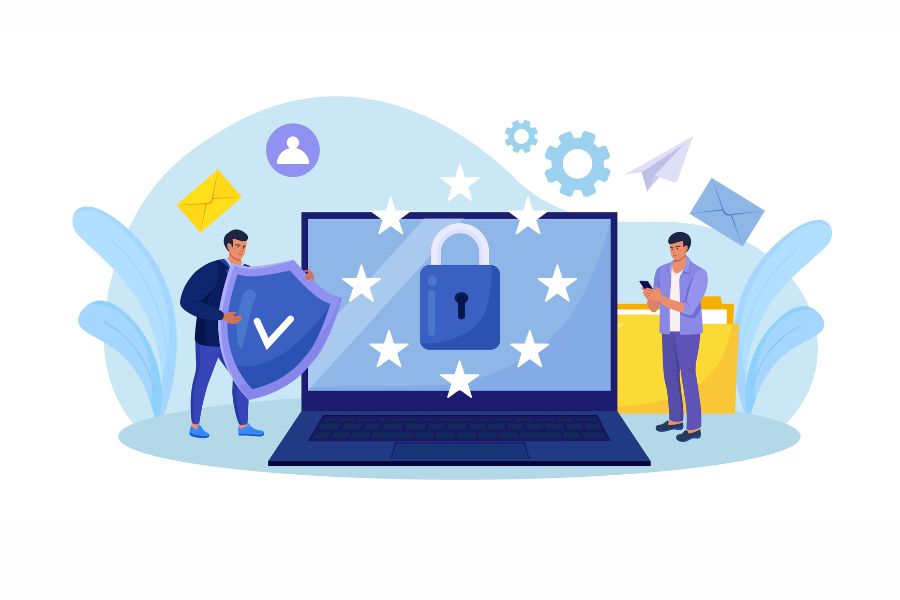Navigating Compliance: GDPR and Beyond in Cybersecurity
July 8, 2024, 13 min read
Welcome to our deep dive into the labyrinth of GDPR and its influential presence in cybersecurity. The General Data Protection Regulation, or GDPR, has transformed how organizations handle personal data and has significant implications for cybersecurity. Let’s explore the various facets of GDPR and unveil how it intertwines with cybersecurity frameworks, requirements, and practices.
GDPR is arguably one of the most comprehensive and impactful data protection regulations. It was designed to give European Union (EU) citizens more control over their data and to unify data protection laws across Europe. Cybersecurity is a crucial aspect of GDPR, as the regulation mandates strict security measures to protect personal data from breaches and misuse. This has prompted organizations worldwide, not just within the EU, to reassess and bolster their cybersecurity strategies to ensure compliance.
One of the significant ways GDPR has affected cybersecurity is by requiring organizations to implement “appropriate technical and organizational measures” to secure personal data. This means businesses must stay abreast of the latest cybersecurity trends and technologies to protect against ever-evolving cyber threats. Compliance is not just a one-time effort but an ongoing process that involves continuous monitoring, risk assessments, and updates to security protocols.
Moreover, GDPR’s reach extends beyond conventional data security practices. It also encompasses the ethical handling of data and emphasizes transparency and accountability in how personal data is processed. This holistic approach means that cybersecurity measures must be integrated into the core operations of an organization. Companies are now obligated to document their data processing activities, conduct regular audits, and ensure that data protection principles are embedded throughout their systems and processes.
Another critical aspect of GDPR that intertwines with cybersecurity is the requirement for data breach notifications. Under the regulation, organizations must report certain types of data breaches to the relevant supervisory authority within 72 hours of becoming aware of the breach. If the breach poses a high risk to the rights and freedoms of individuals, the affected individuals must also be informed without undue delay. This has necessitated the establishment of robust incident response plans and protocols to detect, report, and manage data breaches effectively.
In cybersecurity, GDPR has introduced the principle of “data protection by design and by default.” This principle requires that data protection be considered from the outset and throughout the lifecycle of any project or system involving personal data. It encourages organizations to adopt proactive measures, such as data encryption, access controls, and pseudonymization, to mitigate risks to personal data. By embedding data protection into their core practices, organizations can better safeguard against cyber threats and comply with GDPR requirements.
What Does GDPR Mean for Cybersecurity?
GDPR, enacted in May 2018, primarily aims to protect EU citizens’ data. For cybersecurity, this means enhanced measures to safeguard data against breaches and unauthorized access. Under GDPR, organizations are required to implement robust security protocols to protect personal data, which directly impacts how cybersecurity strategies are formulated and executed.
The regulation necessitates a comprehensive assessment of current cybersecurity practices within an organization to ensure they meet the mandated standards. This involves not only adopting advanced technical measures but also embedding a culture of data protection across the entire organization. Employees at all levels must be aware of the GDPR requirements and trained to handle personal data securely and responsibly.
Moreover, GDPR emphasizes maintaining data integrity and confidentiality at all times. This goes beyond just fortifying digital infrastructure against cyber attacks. It also includes implementing strict access controls, regular monitoring, and auditing data handling processes to detect and mitigate potential vulnerabilities promptly. Companies must establish clear policies and protocols that regulate who can access the data and under what circumstances.
Regular risk assessments are also a cornerstone of GDPR compliance. By systematically identifying and evaluating potential threats to personal data, organizations can deploy targeted security measures to address specific risks. These assessments should be dynamic and ongoing, ensuring that cybersecurity defenses are continually updated in response to evolving threats and advancements in technology.
Another critical aspect of GDPR is the swift and transparent response to data breaches. Organizations must not only protect personal data proactively but also have mechanisms in place to handle incidents when they occur. This includes notifying relevant authorities and affected individuals within the specified timeframe, as well as taking immediate corrective actions to prevent further breaches. Such preparedness can significantly mitigate the impact of data breaches and help maintain trust with customers and stakeholders.
Core Principles and Penalties Under GDPR
GDPR is built on core principles that dictate data protection practices, and failure to comply can result in hefty penalties. At the heart of GDPR lies the commitment to data minimization, ensuring that organizations collect only the data necessary for specified purposes. This principle reduces the risk associated with excessive data collection and helps maintain trust with data subjects.
Another cornerstone of GDPR is integrity, which mandates that personal data should be accurate and kept up to date. This involves regular data review and correction processes to prevent erroneous or outdated information from being used, which could potentially harm individuals and the organizations involved. The principle of integrity also extends to ensuring that data remains intact and unaltered during processing and storage.
Confidentiality under GDPR emphasizes the importance of protecting data from unauthorized access, breaches, and abuses. Organizations are required to implement strong security measures, such as encryption and access controls, to safeguard personal data throughout its lifecycle. This minimizes the risk of data leakage and ensures that sensitive information remains secure.
Accountability is another vital principle, requiring organizations to take responsibility for their data protection practices. This includes maintaining documentation of data processing activities, conducting regular audits, and demonstrating compliance with GDPR regulations. Accountability ensures that organizations are not only compliant but also capable of proving their compliance to regulators.
The penalties for non-compliance with GDPR are severe, potentially reaching up to 4% of a company’s global annual turnover or €20 million, whichever is higher. These fines are designed to be dissuasive and proportionate to the severity of the infraction. Beyond financial penalties, non-compliance can result in significant reputational damage, loss of customer trust, and legal complications, all of which underscore the importance of adhering to GDPR regulations.
Understanding and implementing these core principles is crucial for any organization handling personal data. It ensures that data is not only protected but also managed in a manner that respects the privacy and rights of individuals. This rigorous approach to data protection fosters a culture of privacy within the organization and positions it as a trustworthy entity in the eyes of customers and partners alike.
Organizations must adopt various security controls to comply with GDPR. Implementing these controls not only helps in meeting regulatory obligations but also fortifies the overall cybersecurity framework of the organization. Here are some critical controls that should be considered:
- Encryption: Encrypting personal data is one of the fundamental requirements under GDPR. By converting data into a form that cannot be easily understood by unauthorized parties, encryption ensures that even if data is intercepted, it remains unusable. Advanced encryption standards (AES) or other encryption algorithms should be employed to provide robust protection for both stored data and data in transit.
- Access Controls: Implementing stringent access controls is vital for protecting personal data. This involves restricting access to data based on user roles and responsibilities to ensure that only authorized personnel can view or manipulate the data. Multi-factor authentication and role-based access control (RBAC) systems can significantly enhance access management.
- Data Masking: Data masking techniques hide specific parts of data to protect sensitive information, such as social security numbers or credit card details. By substituting actual data with fictional but realistic data, organizations can minimize the risk of exposure while maintaining functional data usability for testing and development purposes.
- Regular Audits: Conducting regular audits is essential for ensuring ongoing compliance with GDPR security measures. Audits help in identifying vulnerabilities and potential non-compliance issues, allowing organizations to take corrective action promptly. These audits should include comprehensive reviews of data protection policies, access logs, and incident management procedures.
- Breach Notification: Implementing robust breach notification protocols is a critical aspect of GDPR compliance. Organizations must promptly notify relevant authorities and affected individuals in the event of a data breach involving personal data. A well-defined incident response plan that includes transparent communication strategies and predefined notification templates can help ensure swift and effective breach response.
Additional security measures can further bolster GDPR compliance efforts. For example, employing data loss prevention (DLP) tools can help monitor data flows and prevent unauthorized data transfers. Regular security awareness training for employees ensures that everyone in the organization understands the importance of data protection and is equipped to handle data responsibly.
Furthermore, integrating advanced threat detection systems can enhance the organization’s ability to detect and respond to potential security threats in real-time. These systems use machine learning algorithms and behavioral analytics to identify abnormal activities that may indicate a security breach. By proactively monitoring network traffic and user actions, organizations can mitigate risks before they escalate.
It’s also crucial to engage in continuous risk assessments to adapt to evolving threats and ensure that security measures remain effective. Regularly updating security policies and procedures to reflect emerging best practices and regulatory requirements will help maintain a robust defense against potential data breaches.
By adopting a comprehensive approach to security controls, organizations can ensure that they not only comply with GDPR but also protect their valuable data assets, safeguard their reputation, and build trust with their clients and customers. Effective data protection practices are not only a legal obligation but also a competitive advantage in today’s data-driven world.
GDPR’s Impact on Data Controllers and Processors
GDPR delineates specific responsibilities for data controllers and processors. Data controllers, who determine the purpose and means of processing personal data, must ensure that data is processed lawfully, transparently, and securely. This requires implementing stringent measures and detailed protocols that align with GDPR’s core principles. For example, data controllers must have comprehensive documentation of the data processing activities, which includes the type of data collected, the purpose of collection, and the duration for which the data will be stored.
Data controllers are also responsible for conducting regular impact assessments. These assessments evaluate the potential risks to personal data and outline mitigation strategies. In essence, data controllers function as the central decision-makers who bear the ultimate responsibility for the lawful processing of personal data.
Data processors, who handle data on behalf of controllers, must comply with these security measures and report data breaches immediately. They act under the instructions of the data controller and are forbidden from processing data for their own purposes. This mandates that processors have robust security frameworks that can quickly detect and respond to data breaches. Immediate reporting of breaches to data controllers is crucial, as it allows for timely notification to data subjects and regulators, minimizing potential harm and penalties.
Furthermore, processors are required to maintain a record of all categories of processing activities carried out on behalf of the controller. This includes maintaining an up-to-date log of all incidents and potential security threats. By ensuring that strict protocols are adhered to, data processors uphold the security standards set by data controllers, facilitating a systematic approach to compliance with GDPR. These records are vital in case of audits by supervisory authorities.
This dynamic ensures that every entity involved in data handling maintains high standards of cybersecurity. Both data controllers and processors must engage in continuous monitoring and improvement of their security measures. This collaborative effort ensures that personal data is guarded against unauthorized access, loss, and other threats, thereby fostering a culture of transparency and accountability. This secure environment not only builds trust with customers but also enhances the overall reputation of the organization.
GDPR and Cybersecurity Requirements
To meet GDPR’s stringent requirements, organizations must establish a GDPR-compliant cybersecurity framework. This involves a systematic and comprehensive approach that addresses various aspects of data protection and security. Ensuring compliance with GDPR not only helps avoid hefty fines but also fosters trust among customers and stakeholders.
One of the foundational elements of this framework is conducting regular risk assessments. Risk assessments involve identifying potential vulnerabilities in the organization’s systems and processes that could lead to data breaches or unauthorized access to personal data. By understanding where weaknesses lie, organizations can prioritize and implement measures to mitigate these risks effectively. This proactive approach helps in preemptively addressing issues before they become significant problems.
Another crucial aspect is maintaining meticulous documentation. GDPR mandates that organizations keep detailed records of their data processing activities and the security measures they have in place. This documentation serves several purposes: it provides a clear trail for audits, helps in demonstrating compliance during inspections, and ensures that there is transparency in how data is managed. Detailed documentation includes records of data flow maps, data protection impact assessments (DPIAs), and the results of security audits. It acts as evidence that the organization is taking data protection seriously and complying with GDPR requirements.
Employee training is also indispensable in a GDPR-compliant cybersecurity framework. Employees are often the first line of defense against data breaches, making it essential that they are well-versed in GDPR and cybersecurity best practices. Regular training sessions help employees understand the importance of data protection, how to recognize potential threats, and the procedures to follow in case of a data incident. This can include phishing awareness, secure data handling procedures, and proper use of cybersecurity tools. A well-informed workforce significantly reduces the risk of accidental data breaches.
An effective incident response plan is crucial for addressing data breaches swiftly and effectively. In the event of a data breach, organizations must act quickly to contain the breach, minimize damage, and notify the relevant authorities and affected individuals as required by GDPR. A robust incident response plan includes predefined procedures for identifying and addressing different types of data breaches, coordination between various departments, and communication strategies. Regular drills and simulations can help in refining the response plan and ensuring preparedness.
Additionally, organizations should consider integrating advanced cybersecurity technologies and practices into their framework. This could include implementing intrusion detection systems, continuous monitoring solutions, and encryption protocols. By leveraging the latest cybersecurity tools, organizations can enhance their ability to detect and respond to threats in real-time. Regular vulnerability assessments and penetration testing can also help in identifying and rectifying security gaps proactively. Adopting a holistic approach to cybersecurity that encompasses people, processes, and technology is key to achieving GDPR compliance and protecting personal data effectively.
Welcome to our deep dive into the labyrinth of GDPR and its influential presence in the world of cybersecurity. The General Data Protection Regulation, commonly known as GDPR, has transformed how organizations handle personal data and has significant implications for cybersecurity. Let’s explore the various facets of GDPR and unveil how it intertwines with cybersecurity frameworks, requirements, and practices.
What Does GDPR Mean for Cybersecurity?
GDPR, enacted in May 2018, primarily aims to protect EU citizens’ personal data. For cybersecurity, this means enhanced measures to safeguard data against breaches and unauthorized access. Under GDPR, organizations are required to implement robust security protocols to protect personal data, which directly impacts how cybersecurity strategies are formulated and executed.
Core Principles and Penalties Under GDPR
GDPR is built on core principles that dictate data protection practices, and failure to comply can result in hefty penalties. Key principles include data minimization, integrity, confidentiality, and accountability. Penalties for non-compliance are severe, potentially reaching up to 4% of a company’s global annual turnover. These stringent regulations necessitate a rigorous approach to cybersecurity to avoid financial and reputational damage.
What Security Controls Should You Consider Under GDPR?
Organizations must adopt various security controls to comply with GDPR. Some critical controls include:
- Encryption: Encrypting personal data to protect it from unauthorized access.
- Access Controls: Restricting access to data based on user roles and responsibilities.
- Data Masking: Obscuring specific parts of the data to protect sensitive information.
- Regular Audits: Conducting routine audits to ensure compliance with GDPR security measures.
- Breach Notification: Implementing protocols to promptly notify authorities and individuals in the event of a data breach.
GDPR’s Impact on Data Controllers and Processors
GDPR delineates specific responsibilities for data controllers and processors. Data controllers, who determine the purpose and means of processing personal data, must ensure that data is processed lawfully, transparently, and securely. Data processors, who handle data on behalf of controllers, must comply with security measures and report data breaches immediately. This dynamic ensures that every entity involved in data handling maintains high standards of cybersecurity.
GDPR and Cybersecurity Requirements
To meet GDPR’s stringent requirements, organizations must establish a GDPR-compliant cybersecurity framework. This involves:
- Risk Assessments: Regularly assessing risks to personal data and implementing measures to mitigate them.
- Documentation: Keeping detailed records of data processing activities and security measures.
- Training: Providing adequate training for employees on GDPR and cybersecurity best practices.
- Incident Response: Developing an incident response plan to address data breaches swiftly and effectively.
Developing a GDPR-Compliant Cybersecurity Strategy
Creating a robust GDPR-compliant cybersecurity strategy requires understanding the specific needs of your organization and tailoring security measures accordingly. This strategy should integrate technical and organizational measures to protect data, such as advanced cybersecurity tools, regular vulnerability assessments, and a culture of data protection awareness within the organization. By doing so, businesses can not only comply with GDPR but also enhance their overall cybersecurity posture.
However, developing such a strategy is not without its challenges. Organizations must navigate a complex landscape of data protection laws and cybersecurity risks. Conducting thorough risk assessments to identify potential vulnerabilities and address them proactively is critical. These risk assessments should be regular and comprehensive, covering all aspects of data processing and protection.
An essential aspect of a GDPR-compliant cybersecurity strategy is documentation. Keeping detailed records of data processing activities, security protocols, and compliance measures is crucial. This documentation not only aids in compliance but also serves as a valuable resource during audits and investigations.
Training is another cornerstone of maintaining a GDPR-compliant cybersecurity strategy. Employees should be well-versed in GDPR requirements and cybersecurity best practices. Regular training sessions can help ensure that everyone in the organization understands their role in protecting personal data and preventing breaches.
Incident response planning is also vital. A well-defined incident response plan can help organizations quickly and effectively handle data breaches, thereby minimizing the impact on individuals and the organization itself. This plan should outline the steps to be taken in the event of a breach, including communication strategies with affected parties and regulatory authorities.
In essence, GDPR’s implications for cybersecurity are extensive and multifaceted. The regulation demands a vigilant, proactive stance on data protection, urging organizations to prioritize cybersecurity in their operational and strategic planning. By doing so, businesses not only stay compliant with GDPR but also fortify their resilience against the growing landscape of cyber threats.




























